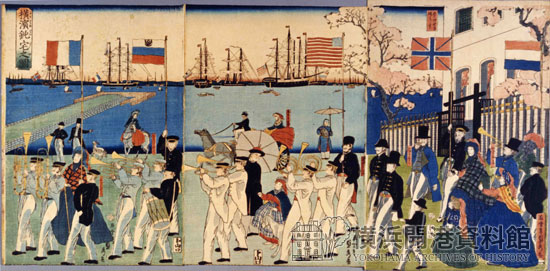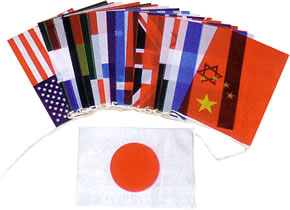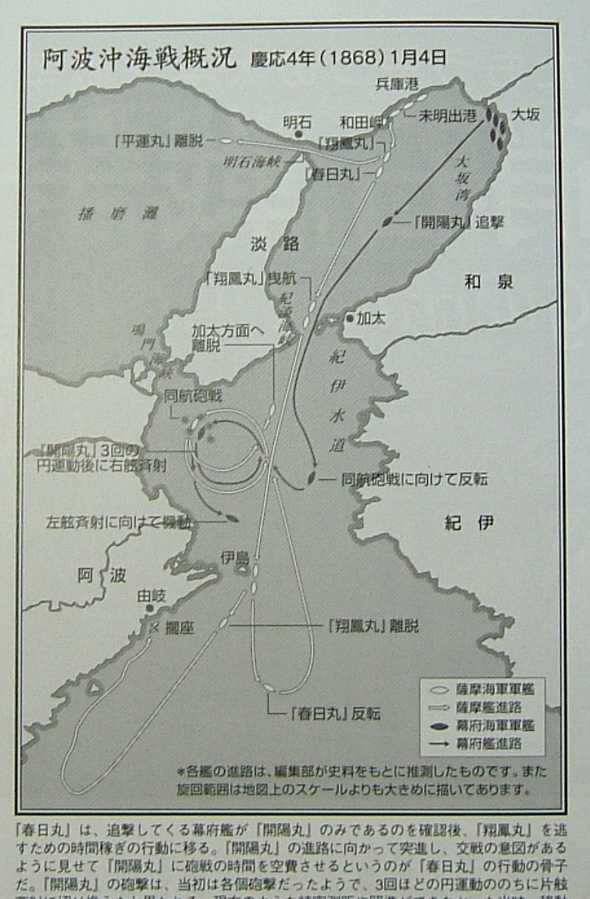This page contains Japanese characters.
 |  |
| 5-power flags | Bankoku-ki |
the Ansei Five-Power Treaties
Boshin War(1868-1869)
Charter Oath
Japanese people had done festivals of farming rice for a long times. The most important festivals are in spring and fall. Commons enjoyed seeing children playing the gyms in a field of an elementary school in spring and fall. Parents rested farming whole a day. Every school all over Japan showed chained flags called bankoku-ki(literally 10 thousand nations flags) in the mid of Meiji era. Expo was translated into bankoku hakurankai.
Once a smart bureaucrat translated 'League of Nations' into 'Kokusai (International) Renmei (League).' Japanese people like the word, Kokusai. Some universities have a faculty of Kokusai. I do not know what to study at the faculty. At last a princess have entered ICU (International Christian University) for the first time, though princes and princesses entered Gakushuin usually. Boy students of Gakushuin wear a traditional IJN officer style uniform even now, as Mikado Akihito wore it when childhood. Gakushuin was not for commons but Peers School before the Pacific War.
Powers admitted Japan as one of powers after the Japanese-Russo War. But all the 5 nations above the picture became the enemy of Japan in the Pacific War, though Japan had not been able to withdraw the troops in China. How leaders of Japan thought cease fire against US and UK, when Government broke up the war? Government declared the Pacific War (Dai Toua Sensou) without referring to international law, while leaders of Meiji declared the Japanese-Qing War and the Japanese-Russo War under international law.
Matsumoto, p289-292
League of Nations
-
Iyashikumo Kokusai hou (international law) ni motorazarukagiri, sorezore Kennou ni oujite issai no syudan wo tukusu ni oite, kanarazu Irou nakaramu-koto wo kiseyo.
[1st Aug 1894, Japanese-Qing War]
Oyoso Kokusai jyouki(international rule) no hani ni oite issai no syudan wo tukusi, Isan nakaramu koto wo kiseyo.
[10th Feb 1904, Japanese-Russo War]
International rescue (Kokusai kyujyo-tai)
| Parties | Ratification |
| Spain | 1930Aug06 |
| Switzerland | 1930Dec19 |
| Italy | 1931Mar24 |
| Serbia (Republic of) | 1931May20 |
| Portugal | 1931Jun08 |
| Australia | 1931Jun23 |
| India | 1931Jun23 |
| New Zealand | 1931Jun23 |
| South Africa | 1931Jun23 |
| United Kingdom | 1931Jun23 |
| Norway | 1931Jun24 |
| Sweden | 1931Jul03 |
| Latvia | 1931Oct14 |
| Romania | 1931Oct24 |
| USA | 1932Feb04 |
| Brazil | 1932Mar23 |
| Belgium | 1932May12 |
| Poland | 1932Jun29 |
| Mexico | 1932Aug01 |
| Denmark | 1932Aug05 |
| Netherlands | 1932Oct05 |
| Canada | 1933Feb20 |
| Chile | 1933Jun01 |
| Egypt | 1933Jul25 |
| Germany | 1934Feb21 |
| Turkey | 1934Mar10 |
| Iraq | 1934May29 |
| France | 1935Aug21 |
| China | 1935Nov19 |
Jiei-tai iraku haken
International song
When I got a job in a company of Japan, We have to learn singing a song of May Day, being royal to the labor union. The song was made in 1922. I do not remember all, but I remeber a phrase, 'Wake up, internationl labors! (tate bankoku no roudou-sha).' The International was a national anthem of Soviet Union. We say union kumiai. A lots of Yakuza groups call themselves xxxkumi.
After the Pacific War, Japanese people also liked a word, culture 'bunka'. Now is another word, global 'guroubaru'. An British ambassador wrote an opinion on Mainichi Newspaper in 2008. He suggested to 'international' 5 times and 'global' twice.
POW
Government signed Convention relative to the Treatment of Prisoners of War on 27 July 1929. But Mikado did not ratify, because Privy Council did not agree. Then Deputy Foreign Affair Minister requested an opinion to Army and Navy. Deputy Navy Minister replied negative. He told 4 reasons to oppose the treaty on 15 November 1934.
- Japanese soldiers do not expect POWs. So the treaty is obliged to one side of Japan.
- If enemy aircraft raided and the enemy soldiers wanted to be POWS after the raid, The range of raid would be to expand
- There is military trouble that a third party can talk POWs
- The punishment rule of POWs treats better than Japanese usulal soldiers. So 4 Naval laws (海軍懲罰令、海軍刑法、海軍軍法会議法、海軍監獄令) have to be revised.
US asked Government how to treat POW via Switzland on 27 December 1941 as well as UK via Argentina on 3 January 1942. Government replied Switzland and Argentia "mutatis mutandis". Japan and US agreed how to treat civilians in the Pacific War in February[21]. A Japanese official executed a representive of ICRC in Borneo on 13 May 1943.
Horyo Shoguhou
Shin turezuregusa
After the Pacific War, Japan ratified Fourth Geneva Convention (1949) on 21 October 1953. Japan ratified addtitional Protocol I relating to the Protection of victims of international armed conflicts and Protocol II relating to the protection of victims of non-international armed conflicts on 28 February 2005.
Geneva Conventions
Japan got tariff autonomy and could tie equal treaty with US on 21 February 1911 at last. It took 52 years to revise. Japan knew that military power was the most important to be independent from foreign powers. US actioned as well as ancient arrogant democratic super power of Athen did, I think.
As for Chinese debt issue, UK, US and Japan could not agree with 北京関税会議 in 1925-1926. UK approved of 2.5% of tariff of import in China in December 1926. US expressed negotiation with China in January 1927. And Canton Government expressed void of unequal treaties with powers in July 1928. US approved of Canton Government and the tariff autonomy in July. UK did in August. Tanaka Cabinet did not approve of tariff autonomy but 2.5% tariff on 30 January 1929.(2) Tanaka Cabinet approved of Canton Government on 3 June 1929.(4) Hamaguchi Cabinet decided of Chinese tariff autonomy in January 1930 and signed Chinese tariff autonomy on 6 May.(3)
Japan occupied German Saipan and Truk in WWI. While Australia occupied New Guniea. Saipan is located in the neighbor of Guam. I think Japan had not occupy most of German territories in the Pacific after all. US built the Panama Canal in 1914. Twenty-One Demands of Japan ocurred Chinese nationalism in 1915. Japan was one of powers. USN began to study campaign plans in the Pacific how USN would occupy islands and protect invasion forces. While IJN began to study how to intercept USN near Saipan. But oil fueling in the ocean and aircraft changed real naval operaions in 1940s. IJN aircraft raided Parl Harbor while military aircraft on a USN carrier attacked Tokyo.
Japan, US and UK agreed the status quo in the Pacific on 6 February 1922. There were strange limit about fortifications. US succeeded in excluding Hawaii where US annexed in 1898. While Japan annexed Taiwan in 1895, Okinawa in 1872. I do not know why Japanese people did not refer to this article. Didn't the Japanese remember how black ships invaded Japan via Taiwan, Okinawa and Ogasawara (Bonin) in 1850s? Did they think old shiodome line was enough to defend Japan? Shiodome was Bakufu's imaginary defense line at the Uraga Channel in Edo era. Once again Japan stood and stands in the pheripherial of the Pacific.
-
Article XIX
The United States, the British Empire and Japan agree that the status quo at the time of the signing of the present Treaty, with
-
Page 253
(1) The insular possessions which the United States now holds or may hereafter acquire in the Pacific Ocean, except (a) those adjacent to the coast of the United States, Alaska and the Panama Canal Zone, not including the Aleutian Islands, and (b) the Hawaiian Islands;
(2) Hong Kong and the insular possessions which the British Empire now holds or may hereafter acquire in the Pacific Ocean, east of the meridian of 110° east longitude, except (a) those adjacent to the coast of Canada, (b) the Commonwealth of Australia and its Territories, and (c) New Zealand;
(3) The following insular territories and possessions of Japan in the Pacific Ocean, to wit: the Kurile Islands, the Bonin Islands, Amami-Oshima, the Loochoo Islands, Formosa and the Pescadores, and any insular territories or possessions in the Pacific Ocean which Japan may hereafter acquire.
The maintenance of the status quo under the foregoing provisions implies that no new fortifications or naval bases shall be established in the territories and possessions specified; that no measures shall be taken to increase the existing naval facilities for the repair and maintenance of naval forces, and that no increase shall be made in the coast defences of the territories and possessions above specified. This restriction, however, does not preclude such repair and replacement of worn-out weapons and equipment as is customary in naval and military establishments in time of peace.
 |
-
1907 Jul30 1st Japanese-Russo Agreement
1910 Jul04 2nd Japanese-Russo Agreement
1912 Jul08 3rd Japanese-Russo Agreement
1916 Jul03 4th Japanese-Russo Agreement
-
1925 Panama
1926 Nicaragua
1933 Nicaragua
| Year | Name | Nationality |
| 1924-27 | Vasily Blyukher | Russia |
| 1927 | Vasily Chuikov | Russia |
| 1930-1937 | Alexander von Falkenhausen | Germany |
| 1934-1935 | Hans von Seeckt | Germany |
| 1938-1939 | Andrey Vlasov | Russia |
| 1942-1944 | Joseph Stilwell | USA |
| 1944-1946 | Albert Coady Wedemeyer | USA |
| 1950-1970 | Tomita Naosuke | Japan |
China was disappointed that other powers fixed colonization of China. So China came near to Russia (Sino-Soviet Non-Aggression Pact) at first. The next was Germany (Sino-German cooperation). China had invited Russian military advisors before 1927. China expelled communists in 1927. The table shows Russian, German, American and Japanese military advisors of Chiang Kai-shek. China had adopted foreigners to control foreigners ( 夷 wo motte 夷 wo seisuru ) in her long history. Okamura recommended Tomita to Chiang. Okamura also was a military advisor of 北洋軍閥 孫伝芳.
-
満州が占領されてすでに6年、---今や敵は北京の入口である蘆溝橋にまで迫っている。---わが民族の生命を保持せざるを得ないし、歴史上の責任を背負わざるを得ない。中国民族はもとより和平を熱望するが、ひとたび最後の関頭に至れば,あらゆる犠牲を払っても、徹底的に抗戦するほかなし。
Why did Konoe announce such a declaration to China on 15 August 1937, even though he recognized China issue and domestic militarism correct?
-
帝国夙に東亜の永遠の平和を冀念し、日支両国の親善提携に力を効せること久しきに及べり。
然るに南京政府は排日侮日を以て国論昂揚と政権強化の具に供し、自国国力の過信と帝国の実力を軽視の風潮と相俟ち、更に赤化勢力と荀合して反日侮日兪々甚しく、以て帝国に敵対せんとするの気運を情勢せり。
近年幾度か惹起せる不祥事件何れも之に因由せざるべし。今次事変の発端も亦此の如き気勢がその爆発点を偶々永定河畔に選びたるに過ぎず、通州に於ける神人共に許せざる残虐事件の因由亦茲に発す。
更に中南支に於ては支那側の挑戦的行動に起因し帝国臣民の生命財産既に危殆に瀕し、我居留民は多年営々として建設せる安住の地を涙を呑んで遂に一時撤退するの已むなきに至れり。
顧みれば事変発生以来婁々声明したる如く、帝国は隠忍に隠忍を重ね事件の不拡大を方針とし、努めて平和的且局地的に処理せんことを企図し、平津地方に於ける支那軍婁次の挑戦及不法行為に対しても我が支那駐屯軍は交通線の確保及我が居留民保護の為真に已むを得ざる自衛行動に出でたるに過ぎず。 而も帝国政府は夙に南京政府に対して挑戦的言動の即時停止と現地解決を妨害せざる様注意を喚起したるも拘らず,南京政府は我が勧告を聴かざるのみならず、却て益々我が方に対し、戦備を整え、厳存の軍事協定を破りて顧みることなく、軍を北上せしめて我が支那駐屯軍を脅威し、又漢口上海其の他に於ては兵を集めて兪々挑戦的態度を露骨にし、上海に於ては遂に我に向って砲火を開き帝国軍艦に対して爆撃を加ふるに至れり。
此の如く支那側が帝国を軽侮し不法暴虐至らざるなく全支に亘る我が居留民の生命財産危殆に陥るに及んでは帝国として最早穏忍其の限度に達し支那軍の暴戻を膺懲し以て南京政府の反省を促す為今や断固たる措置をとるの已むなきに至れり。
Curtius
Soembing
rannjinnroku
 |  |
| Sinagawa Battle | Awa Battle |
Gunzo, p162-169, no70
Kaiten
Kaiyo-maru
Kasuga-maru
Shimazu Nariakira
| Year | USN | RN | IJN | IJN/USN |
| 1919 | 205.2 | 62.8 | 13.4 | 6.5% |
| 1920 | 67.6 | 28.8 | 15.9 | 23.5% |
| 1930 | 61.2 | 43.8 | 18.0 | 29.4% |
| 1934 | 56.3 | 53.9 | 36.5 | 64.8% |
| 1935 | 77.7 | 61.3 | 39.1 | 50.3% |
| 1936 | 92.5 | 71.8 | 38.6 | 41.7% |
Dependent on US economy
US had invested to China and Japan as follows. As matter of fact, Japan needed US dollars to develope domestic industries. Ishibashi Tanzan understood the economic reality well.
There were few military leaders to know US economy or society well. Leaders from Cadet school or Naval academy governed our nation in 1930 - 1945. Most of Japanese leaders thought world wide issues like Ishihara, Tojyo and Kishi. They longered Japan could develop by herself like Soviet Union under controlled economy. Soviet had resources and land to grow food.
Correctly Gandhi understood dollars cool in Asia, who knew that Japan could not be independent from US.
(1) 日露戦争
(2) Kawada, p39-40
(3) Kawada, p64
(4) Kawada, p42
[5] Matsumoto, p10-11
[6] Matsumoto, p173
[7] 馬 暁華 America no Chugoku taiken
[8] Nihon6, p170
[11] Hull no 極東政策 no 岐路
[21] Ohuchi, p197

aboutMe
© 2008-2011 Enoki Sensor All Rights Reserved